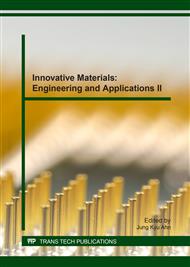[1]
H. AminPour, N. Rizzi, A one-dimensional continuum with microstructure for single-wall carbon nanotubes bifurcation analysis. Math. Mech. Solids. 21 (2016) 168-181.
DOI: 10.1177/1081286515577037
Google Scholar
[2]
W. H. Chen, H. C. Cheng, Y. L. Liu, Radial mechanical properties of single-walled carbon nanotubes using modified molecular structure mechanics. Comp. Mater. Sci. 47 (2010) 985-993.
DOI: 10.1016/j.commatsci.2009.11.034
Google Scholar
[3]
R. Kolahchi, Bidgoli, A. M. Bidgoli, Size-dependent sinusoidal beam model for dynamic instability of single-walled carbon nanotubes. Appl. Math. Mech. -Engl. 37 (2016) 265-274.
DOI: 10.1007/s10483-016-2030-8
Google Scholar
[4]
X. F. Wang, Z. J. Xu, Z. Y. Zhu, Reversible mechanical bistability of carbon nanotubes under radial compression. Chem. Phys. 334 (2007) 144-147.
DOI: 10.1016/j.chemphys.2007.02.020
Google Scholar
[5]
J. W. Hu, Response of Seismically Isolated Steel Frame Buildings with Sustainable Lead-Rubber Bearing (LRB) Isolator Devices Subjected to Near-Fault (NF) Ground Motions. Sustainabil. 7 (2015) 111-137.
DOI: 10.3390/su7010111
Google Scholar
[6]
M. R. Kaloop, J. W. Hu, Y. Bigdeli, Identification of the Response of a Controlled Building Structure Subjected to Seismic Load by Using Nonlinear System Models. Appl. Sci. 6 (2016) 301.
DOI: 10.3390/app6100301
Google Scholar
[7]
A. Duzynska, M. Swiniarski, A. Wroblewska, Phonon properties in different types of single-walled carbon nanotube thin films probed by Raman spectroscopy. Carbon. 105 (2016) 377-386.
DOI: 10.1016/j.carbon.2016.04.064
Google Scholar
[8]
T. Sun, X. Peng, S. Jiao, et al. Simulation of Particle Dynamics of Nano-Magnetorheological Materials in External Magnetic Fields. J. Comput. Theor. Nanos. 6 (2014) 1518-1522.
Google Scholar
[9]
M. Sedlacik, R. Moucka, Z. Kozakova, et al. Correlation of structural and magnetic properties of Fe3O4 nanoparticles with their calorimetric and magnetorheological performance. J. Magn. Magn. Mater. 326, 7 (2013).
DOI: 10.1016/j.jmmm.2012.08.039
Google Scholar
[10]
C. Y. Li, T. W. Chou, A structural mechanics approach for the analysis of carbon nanotubes, Int. J. Solids. Struct. 40 (2003) 2487-2499.
Google Scholar
[11]
W. H. Chen, H. C. Cheng, Y. C. Hsu, Mechanical properties of carbon nanotubes using molecular dynamics simulations with the inlayer van der Waals interactions. Computer Modeling in Engineering and Sciences, Tech Science Press, 20 (2): 123-145, (2007).
Google Scholar
[12]
W. D. Cornell, P. Gieplak, C. I. Bayly, et al. A Second Generation Force Field for the Simulation of Proteins, Nucleic Acids, and Organic Molecules. J. Am. Chem. Soc. 117(1995) 5179-5197.
DOI: 10.1021/ja00124a002
Google Scholar
[13]
H. C. Cheng, Y. L. Liu, C. H. Wu, et al. On radial breathing vibration of carbon nanotubes. Comput. Methods Appl. Mech. Energ. 199 (2010) 2820-2827.
Google Scholar


